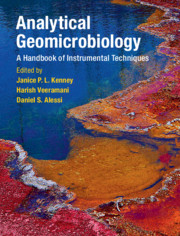Book contents
- Analytical Geomicrobiology A Handbook of Instrumental Techniques
- Analytical Geomicrobiology
- Copyright page
- Contents
- Contributors
- Foreword
- Part I Standard Techniques in Geomicrobiology
- Part II Advanced Analytical Instrumentation
- Part III Imaging Techniques
- 5 Scanning Probe Microscopy
- 6 Applications of Scanning Electron Microscopy in Geomicrobiology
- 7 Applications of Transmission Electron Microscopy in Geomicrobiology
- 8 Whole Cell Identification of Microorganisms in Their Natural Environment with Fluorescence in situ Hybridization (FISH)
- Part IV Spectroscopy
- Part V Microbiological Techniques
- Index
- References
8 - Whole Cell Identification of Microorganisms in Their Natural Environment with Fluorescence in situ Hybridization (FISH)
from Part III - Imaging Techniques
Published online by Cambridge University Press: 06 July 2019
- Analytical Geomicrobiology A Handbook of Instrumental Techniques
- Analytical Geomicrobiology
- Copyright page
- Contents
- Contributors
- Foreword
- Part I Standard Techniques in Geomicrobiology
- Part II Advanced Analytical Instrumentation
- Part III Imaging Techniques
- 5 Scanning Probe Microscopy
- 6 Applications of Scanning Electron Microscopy in Geomicrobiology
- 7 Applications of Transmission Electron Microscopy in Geomicrobiology
- 8 Whole Cell Identification of Microorganisms in Their Natural Environment with Fluorescence in situ Hybridization (FISH)
- Part IV Spectroscopy
- Part V Microbiological Techniques
- Index
- References
Summary
One of the main goals in biogeochemistry is to explore the global relationships between organisms and chemical elements in different ecosystems. A diversity of analytical techniques based on chemical-physical or molecular biological procedures are available to explore different organisms and their abiotic and biotic interactions in a variety of ecosystems. Even though many of these modern analytical techniques are irreplaceable in today´s research, most of them can only provide indirect results because they are built on a “black-box” approach, where the biological species in an ecosystem or a geological environment are disrupted for extraction of nucleic acids, proteins, etc. Essential biological information, such as the morphology of specific species, their location, distribution, association with other organisms in their natural environment, and individual activities and functions, is therefore lost. Fluorescence in situ hybridization (FISH) helps retrieve this information without either cultivation or extraction of cell components, and can therefore provide a quick and useful complement to different “black-box”-based approaches. FISH is based on fluorescently labeled gene probes with a unique nucleotide composition designed to match specific genes in different cellular species. Thus, different biological species can be identified simultaneously with different gene probes labeled with different fluorochromes in their natural environment. The technique has undergone extensive development with around 30 variations for different applications. FISH is evaluated either by microscopy (e.g., fluorescence microscopy, Raman micro spectroscopy, Nano-SIMS), or by nonmicroscope-based methods, such as flow cytometry, microarray technology, or molecular biological methods such as proteomics. This chapter will serve as a guide for sample preparation, selection of appropriate FISH protocols, evaluation and design of gene probes, and evaluation of FISH experiments.
- Type
- Chapter
- Information
- Analytical GeomicrobiologyA Handbook of Instrumental Techniques, pp. 187 - 212Publisher: Cambridge University PressPrint publication year: 2019

